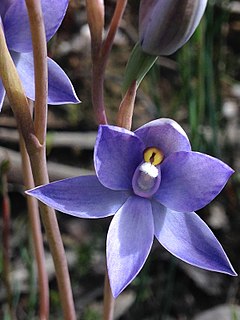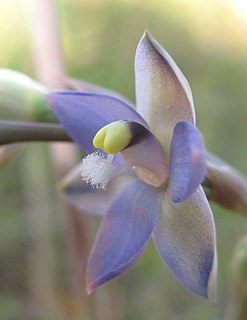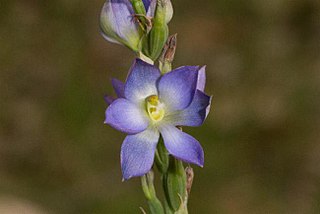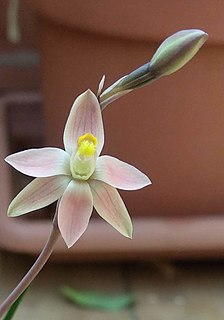
Thelymitra megacalyptra, commonly called the plains sun orchid, is a species of orchid that is endemic to eastern Australia. It has a single erect, fleshy leaf and up to fifteen blue to purplish, sometimes lilac, pink or white flowers with white tufts on top of the anther. It is known as Thelymitra megcalyptra by some authorities.
Thelymitra basaltica, commonly called the grassland sun orchid, is a species of orchid that is endemic to Victoria. It has a single fleshy, channelled, dark green leaf and up to eight small pale blue, self-pollinating flowers which open only slowly on warm to hot days.
Thelymitra batesii, commonly called the plump sun orchid, is a species of orchid that is endemic to South Australia. It has a single fleshy, channelled, dark green leaf and up to eight mauve to bluish purple flowers that are pinkish with darker stripes on the back. The unopened flower buds are distinctly plump.
Thelymitra exigua, commonly called the short sun orchid, is a species of orchid that is endemic to south-eastern Australia. It has a single fleshy, channelled, dark green leaf and up to eight relatively small pale blue flowers with white toothbrush-like tufts on top of the anther.
Thelymitra cyanapicata, commonly called the dark-tipped sun orchid, is a species of orchid that is endemic to South Australia. It has a single fleshy, linear, channelled leaf and up to three small blue or pale purplish to maroon flowers with a dark purplish blue top of the anther.

Thelymitra holmesii, commonly called the blue star sun orchid, is a species of orchid that is endemic to south-eastern Australia. It has a single long, narrow, fleshy leaf and up to nine purplish blue to mauve flowers with a deeply notched lobe on top of the anther.

Thelymitra peniculata, commonly called the trim sun orchid, is a species of orchid that is endemic to southern eastern Australia. It has a single long, erect, fleshy, channelled leaf and up to eighteen deep blue to purple self-pollinating flowers.
Thelymitra viridis, commonly called the green sun orchid, is a species of orchid that is endemic to Tasmania. It has a single erect, fleshy, channelled leaf and up to seven small self-pollinating pale blue to pale purplish flowers. The rest of the plant is a pale green colour.
Thelymitra inflata, commonly called the inflated sun orchid, is a species of orchid that is endemic to south eastern Australia. It has a single long, erect, linear leaf and up to six dark blue to purplish flowers with a very inflated lobe on top of the anther.
Thelymitra lucida, commonly called the glistening sun orchid, is a species of orchid that is endemic to south eastern Australia. It has a single erect, fleshy leaf and up to seven dark blue flowers with the sepals a lighter blue than the petals.

Thelymitra epipactoides, commonly called the metallic sun orchid, is a species of orchid that is endemic to south-eastern continental Australia. It has a single relatively large, leathery leaf and up to twenty large flowers that range in colour from pink to reddish but have a distinctive arrangement of lobes above the anther.

Thelymitra grandiflora, commonly called the giant sun orchid, is a species of orchid that is endemic to South Australia. It has a single large, erect, linear to lance-shaped leaf and up to forty large, dark metallic to greenish blue flowers with darker veins.
Thelymitra silena, commonly called the madonna sun orchid, is a species of orchid that is endemic to Tasmania. It has a single thick, fleshy, channelled leaf and up to fifteen pale blue flowers with an almost spherical yellow lobe on top of the anther.
Thelymitra latiloba, commonly called the wandoo sun orchid or wandoo shirt orchid, is a species of orchid in the family Orchidaceae and endemic to the south-west of Western Australia. It has a single erect, fleshy, channelled, dark green leaf and up to twelve blue flowers with darker blue veins and sometimes flushed with mauve. The lobe on top of the anther is wavy.
Thelymitra occidentalis, commonly called the western azure sun orchid or rimmed orchid, is a species of orchid in the family Orchidaceae and is endemic to the south-west of Australia. It has a single erect, fleshy, channelled, dark green leaf and up to fifteen blue flowers with darker blue veins and sometimes flushed with pink. The lobe on top of the anther has a wavy, yellow crest.

Thelymitra glaucophylla is a species of orchid that is endemic to South Australia. It has a single erect, channelled, pale green leaf and up to fifteen pale blue, mauve or white flowers with an inflated, greyish lobe on top of the anther.
Thelymitra hygrophila, commonly known as the blue star sun orchid, is a species of orchid in the family Orchidaceae and is endemic to a small area of South Australia. It has a single erect, fleshy, channelled leaf and up to five pale blue to cornflower blue flowers which open on warm, humid days. Much of its formal habitat has been cleared and the species is now critically endangered.
Thelymitra latifolia is a species of orchid in the family Orchidaceae and is endemic to South Australia. It has a single broad, flat, dark green and reddish leaf and up to eight blue to mauve flowers which only open on warm, humid days.
Thelymitra odora is a rare species of orchid in the family Orchidaceae and is endemic to a small area of South Australia. It has a single erect, channelled, linear leaf and up to four deep blue flowers. It is similar to T. pauciflora but is distinguished from that species by its slaty grey flower buds and a different lobe on top of the anther.
Thelymitra orientalis is a rare species of orchid in the family Orchidaceae and is endemic to southern continental Australia. It has a single thread-like, cylindrical leaf and a single deep blue, streaked flower. It is similar to T. mucida but is distinguished from that species by its filiform leaf and smaller flower.





